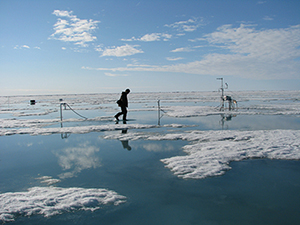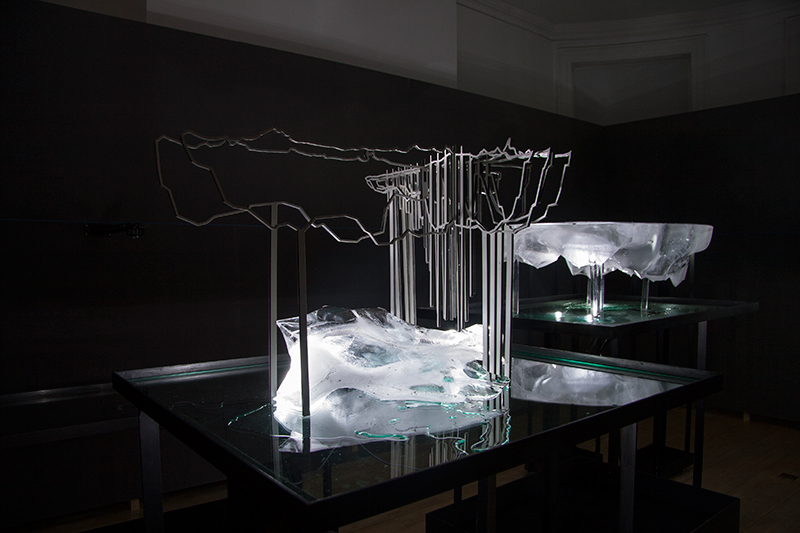
Seven Arctic researchers shared their unconventional methods for communicating scientific developments and discoveries to the public at a workshop held simultaneously with the American Geophysical Union’s 2015 Fall Meeting. The event—Revealing the New Arctic: A Climate Change Communication Workshop—not only explored creative approaches to communicating Arctic change but also revealed scientists’ personal reasons for engaging in outreach.
The meeting was organized by the Study of Environmental Arctic Change (SEARCH) Sea Ice Action Team and facilitated by Andy Revkin, a New York Times environmental journalist. Jennifer Francis (Rutgers University), coleader of the Sea Ice Action Team, helped organize the workshop to raise awareness of the team’s focus on improving communication in Arctic science.
SEARCH executive director Brendan Kelly urged the audience to reexamine the role of science communication in engaging decision makers. He outlined SEARCH’s efforts to develop concise science resources to inform the busy professionals in fast-paced policy realms. Reiterating the policy theme, Mia Bennett, Ph.D. candidate in the Department of Geography at the University of California, Los Angeles, spoke about her efforts to apply perspectives from political and economic geography through her blog Cryopolitics.

Other speakers focused on outreach to the public. Larry Hamilton (University of New Hampshire) discussed public perceptions of Arctic sea ice trends. He explained that “surveys show that many people find the Arctic intriguing, but without personal experience they rely on others to understand how it’s changing.” He added that “improving science communication can help to empower engaged, science-friendly citizens and to inform others who are less engaged but open to learning.”
Marco Tedesco (Columbia University), whose presentation used sonification to transform observations of Greenland’s shrinking ice cover into sound, told the audience to listen to the data. Reflecting on his reasons for participating, he said, “We need to transmit not only information but also knowledge. This is crucial to generate a new social paradigm that can expand into people’s lives and make them understand how crucial the Arctic is and how unprecedented the changes are. Music, for me, is one way to do so.”

Till Wagner (Scripps Institution of Oceanography) presented his novel approach to exhibiting scaled frozen replicas of sea ice floes for museum audiences. The replicas were created from three-dimensional lidar scans taken from the field. One such replica was recently on display at the Architectural Association in London as part of the exhibition Frozen Relics: Arctic Works, a collaboration between ScanLAB Projects, University of Cambridge, and Greenpeace.

Revkin, a master of both the fast-paced Twitter world of communication and developing relationships with scientists, reinforced that successful communication can take many forms. “The array of presentations beautifully demonstrated how climate research and environmental change can be conveyed in captivating ways.” He said the key is to think about what mix of media and strategies makes the most sense for presenting to diverse, distracted, divided audiences.
Audiences with divided opinions are a clear and persistent challenge. Hamilton noted that “some of the confusion about Arctic change comes from organized and politically based science rejection.” Other presenters expressed optimism. Francis explained her appreciation for the creative and varied work highlighted at the event: “It gave me hope that we are winning the war against anthropogenic-climate-change denialism!”
—Matthew L. Druckenmiller, National Snow and Ice Data Center, University of Colorado, Boulder; email: [email protected]; and Jessica Rohde, Interagency Arctic Research Policy Committee (IARPC) Collaborations, Washington, D. C.
Citation:
Druckenmiller, M. L.,Rohde, J. (2016), Communicating Arctic science creatively for diverse audiences, Eos, 97, https://doi.org/10.1029/2016EO057009. Published on 10 August 2016.
Text © 2016. The authors. CC BY-NC-ND 3.0
Except where otherwise noted, images are subject to copyright. Any reuse without express permission from the copyright owner is prohibited.

